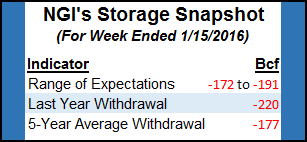NatGas Cash, Futures Part Company; August Adds Couple Pennies
In Tuesday’s cash trading, natural gas put the futures in the rearview mirror and recorded a 5-cent gain to $2.56, while futures tumbled more than 22 cents. Wednesday saw futures nearly return the favor, as the NGI National Spot Gas Average fell 2 cents to $2.54, and futures were able to add a couple of pennies.

Hefty gains in the Northeast and steady pricing in Appalachia were unable to offset losses in the Gulf, Midcontinent, Midwest and Texas. At the close of futures trading, August had added 2.2 cents to $2.786 and September was higher by 1.9 cents to $2.777. August crude oil recovered from its $2-plus shellacking Tuesday and added 83 cents to $47.43/bbl.
“At $2.70 to $2.75, it looks like it could hold,” said a New York floor trader of gas prices. “Boy, did it bounce off $3 though. I don’t see it going up until next week because that’s when the hot weather really comes in.
“It’ll be tough getting through the $2.81 to $2.82 resistance.” If there’s a “small storage number” on Thursday reported by the Energy Information Administration, “it could rally to $2.90, but for right now the trading range is $2.75 to $3.”
There is little doubt of a small injection Thursday. Last year 83 Bcf was injected, and the five-year average stands at 77 Bcf. This week looks to be much smaller, but how small relative to expectations will likely determine the market response.
Citi Futures Perspective estimated 46 Bcf, and IAF Advisors is expecting a 44 Bcf increase. A Reuters poll of 16 traders and analysts revealed a 43 Bcf average with a range of 35 Bcf to 47 Bcf.
In physical market trading, New England points saw gains as temperature forecasts continued above normal. Forecaster Wunderground.com predicted Boston’s steamy high of 93 degrees Wednesday would ease to 82 Thursday and 75 by Friday. The normal high is 81. Chicago’s 90 high Wednesday was seen dropping to 87 Thursday and 86 Friday, 2 degrees above normal.
Gas at the Algonquin Citygate rose 26 cents to $3.56, and deliveries to Iroquois, Waddington gained 11 cents to $3.04. Packages on Tenn Zone 6 200L added 27 cents to $3.55.
Mid-Atlantic pricing wasn’t quite as robust. Gas on Tetco M-3 Delivery was flat at $1.67, but gas bound for New York City on Transco Zone 6 rose 19 cents to $2.85.
Appalachian gas headed west on the REX Zone 3 Expansion gained relative to downstream market points. Gas at Marcellus points was on balance steady, but interconnects with ANR, Panhandle Eastern, and NGPL all fell.
Deliveries to Dominion South added 2 cents to $1.55, and gas priced at Tennessee Zn 4 Marcellus was flat at $1.46. Deliveries on Transco Leidy changed hands 1 cent lower at $1.54.
Deliveries to NGPL in Moultrie County, IL shed 7 cents to $2.62, and packages on Panhandle Eastern in Putnam County, IN also dropped 7 cents to $2.62. Gas priced at the ANR interconnect in Shelby County, IN fell 8 cents to $2.62.
Near-term weather forecasts edged slightly cooler.
“Details continue to be challenging over the next two weeks as we track a seasonal to hot national pattern overall,” said Commodity Weather Group (CWA) in its Wednesday morning report. “There is plenty of energy embedded in the jet stream flow to create thunderstorm (cooler) complications that offset otherwise hotter risks in this pattern type. We see some hotter East Coast shifts in the short-range (mid-upper 90s for Mid-Atlantic late this week) with some cooler Midwest adjustments.”
Wednesday’s six-to-10-day forecast “edged very slightly cooler for the East Coast, Deep South including Texas, as well as the Western U.S., while the 11-15 day inched slightly hotter for many of these same areas,” said CWA President Matt Rogers.
Fundamental market factors were still intact. “The updated temperature forecast was modestly cooler than on Friday but still features mostly warmer than normal conditions over the next two weeks,” said Tim Evans of Citi Futures Perspective in closing comments. “This suggest[s] that Tuesday’s drop in natural gas was primarily a correction to its valuation rather than a shift in its underlying fundamentals.”
Evans is forecasting a 46 Bcf build in Thursday’s storage report, sharply lower than last year’s 85 Bcf injection and a five-year average of 78 Bcf.
Market technicians see the petroleum complex dragging natural gas lower.
The case “for further upside has been put in jeopardy by the close below $2.826,” said United ICAP market technician Brian LaRose after the market closed. “Now it is up to the bears to confirm a top of some kind is in fact in place. To do that bears need to push natgas beneath the 0.236 retracement at 2.671 and swing the technicals in their favor. [I] suspect if the rest of the petro complex continues to slide from here that should not be difficult.”
Tom Saal, vice president at FCStone Latin America in Miami in his work with Market Profile, said to expect the market to test Tuesday’s value area at $2.801 to $2.757 and then move on to test $2.912 to $2.886 or $2.739 to $2.717. He wasn’t sure in what order.
“Recent price volatility makes price direction difficult — just ‘go with’ next move,” he said in a Wednesday morning note to clients.
© 2024 Natural Gas Intelligence. All rights reserved.
ISSN © 1532-1231 | ISSN © 2577-9877 |
